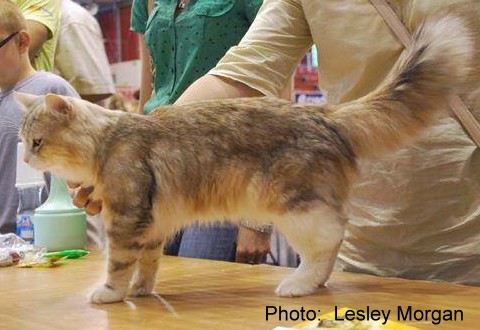
CORIN GENE: SUNSHINE AND SUNSHINE SILVER (BIMETAL) SIBERIANS
Many thanks to Silvia Perego, Eleonora Ruggiero and Lesley Morgan for allowing the use of their photographs and information on this page. The illustration photos of the different phenotypes are copyright of the following catteries that have allowed Eleonora Ruggiero to use the images to help understanding of Siberian Sunshine mutation. This page is an English language web version of her presentation to make the information as widely accessible as possible. Catteries: Veselka - Silvia Perego; Matiblue - Erika Schiavone; Kilgharrah - Eleonora Ruggiero; VivaLaVita - *RU Ekaterina Kudoshina; Simbircit - *BY Lilia Vasilieva; Burian s Secret - Denise Bertasi.
Note on Terminology: "Sunshine" is the genetic name for the golden colour in Siberian Cats. The name "sunshine" comes from the joint work of E. Ruggiero, S. Perego and C. Pallavicino and was proposed for the first time by M. Rusconi. "Bi-metallic" was a nickname for cats showing both silver and golden in their coat i.e. sunshine silver cats. For more pictures and information please look at https://abissini.com. In earlier versions of this article, "extreme sunshine" (wbESIB) was called "copper" (cuSIB).
Note: Corin is also known as "Variable wideband" and uses the symbols VWB+ (wild type), vwbSIB, vwbeSIB, vwbBSH.
GOLDEN COLOUR SIBERIANS
The Siberian is recognised in most colours and patterns, including colourpoints (Neva Masquerade), but not mink or Burmese colour restriction. The colours not recognised are chocolate/lilac, cinnamon/fawn, caramel/apricot in any pattern. Some registries recognise the "golden series" in Siberians. This is not recognised as "golden" by Britain's GCCF (a very conservative cat fancy). Siberian "Golden Tabby (with or without white)," "Golden Tortie Tabby (with or without white)," "Golden Shaded" etc are not viewed as a genetic colour, but as a colour expression of Brown Tabby due to wide agouti banding on the hair shafts which limits the black banding and gives a warmer, brighter tone. This meant that Siberian cats registered as "golden" by FIFE or TICA are re-registered as brown tabby (etc) when transferred into GCCF.
In Persians, Exotics and British Shorthairs, golden seems to result from with the wide band gene(s) and many of the cats have silver (dominant Inhibitor gene) somewhere in their ancestry because the wide band effect was selectively increased when breeding for very pale chinchillas. There is a misconception that when a cat with a silver parent isn't silver, it must be golden by default. Wide Band is independent from the Inhibitor gene; in golden cats, the dominant Inhibitor is absent, but wide band is present. Although "Wb" is treated as a single gene for simplicity, it appears to act as polygenes with an additive effect. In ticked tabby cats without silver, Wide Band restricts the pigment to the end of the hair leaving a pale golden band between the skin and the pigment. Through selective breeding, this effect has been maximised. Initially, the variability of the wide band suggests we use Wb, Wb+ and Wb++ to describe cats with normal, intermediate and greater degrees of Wide Banding. Since then, several DNA mutations for silver and Wideband have been identified and named.
The classic golden colour found in Persian cats is due to the wide-band (Wb) effect which widens the pale brown area at the base of each agouti (banded) hair and confines the darker colour to the ends of the hairs. The paw-pads are either white (i.e. pink) or match the colour at the hair tip. Combined with the silver inhibitor). A golden Persian has wide-band and either has no inhibitor gene or has a recessive form of the inhibitor gene (until the DNA mutation is identified this is uncertain).
"BIMETALLIC" COLOUR SIBERIANS
Judge Lesley Morgan come across a number of strangely coloured Siberian cats that had been nicknamed "bimetallic" as they displayed a mix of silver tabby and golden tabby in their coats. The effect was beyond the rufousing or breakthrough colouring sometimes seen in silver tabbies and in some cats the golden areas increased as the kittens grew into adulthood. The only link she found was that every bimetallic Siberian she saw had close Polish ancestry. Other Siberians had been registered as black silver tortie tabby, but were more likely to be sunshine silver colour.
Siberian breeders had referred to their cats as "golden" but this term clashed with the wide band colour found in Persians, Exotics and British Shorthairs so the official term "sunshine" was adopted instead. The effect resembled the partway stages of the amber (ee) colour change seen in Norwegian Forest Cats or the carnelian (also known as serdolic and copal) mutation in Kurilian Bobtails. Amber and carnelian are caused by different mutations of the extension gene MC1R, but sunshine colour cats have tested negative for these mutations. There are currently no genetic tests for Wide-band or for silver inhibitor, and at the time there were no tests Siberian sunshine, but it could be distinguished visually and by studying pedigrees.
Bimetallic refers to a silver cat that has full expression of rufism on the belly (which can be carried as a recessive trait) as is most commonly seen in Abyssinians. It shows to best effect in ticked/shaded cats. Ticked tabby (code 25) is not permitted by all registries (GCCF in Britain do not permit the ticked tabby pattern), and in these cases it shows to best effect in mackerel pattern cats, especially in broken mackerel pattern (which is further broken up by the long fur) in combination with high grade silver.


3 views of "bimetallic" including a close-up of the fur.
In 2013, Silvia Perego of Veselka Siberian Cattery in Italy described more such cats. Her stud male, Yankee Silviassib*PL, came from Poland and is a black silver tabby with white. When he arrived at her cattery at 4 months old, she noticed that he had a "strange" golden-brown spot on his neck and some little other spots on the back. At first this appeared to be rufism. His first litter included a silver tabby daughter, Veselka Lady, who had the same golden-brown spot on her neck. Another daughter, Veselka Lucy (from a bi-metal mother) also had a golden-brown spot on her neck. Another litter included a daughter, Lizzy, with the same spot. Then Veselka Lady, from the first litter, had her own litter with another silver-and-golden kitten like them. In summer 2013, Yankee had two kittens with the golden-brown patch. Although a judge suggested chimerism, the inheritance pattern indicated a newly emerging gene at work.
Research by Eleonora Ruggiero into the pedigrees of Siberian Cats brought out some intriguing details. For example in "Onix Gloria" lines there are golden tabby Siberians born of non-golden parents. In the pedigrees of "Siberian golden" (provisionally denoted sg), golden offspring are born from two non-golden parents. This means the gene was recessive and only expressed when two copies are inherited. It seems it is not the same as Persian golden (Wb with no inhibitor gene or with homozygous recessive inhibitor). Bimetallic females were often registered as tortoiseshell, but didn't breed as a tortoiseshell as they lacked the red (O) gene (evident when the paw-pads are examined and are never reddish). Their nose leather was dark pink, unlike the nose leather of tabby or genetic tortie cats. In the picture below, the cats have black tail-tips.
According to Inna Shustrova (who supervises breeding in that club), Gelios (or Helios) Onix Gloria's reddish colour came from his mother, Bagriana Itamkhash. "Bagriana" means "scarlet."
The breeder that selected the "reddish" colour used a lot of inbreeding to fix the trait, confirming that it is recessive. The first "bi-metal" cats were probably hidden under the incorrect description of "silver cats with very high rufism."
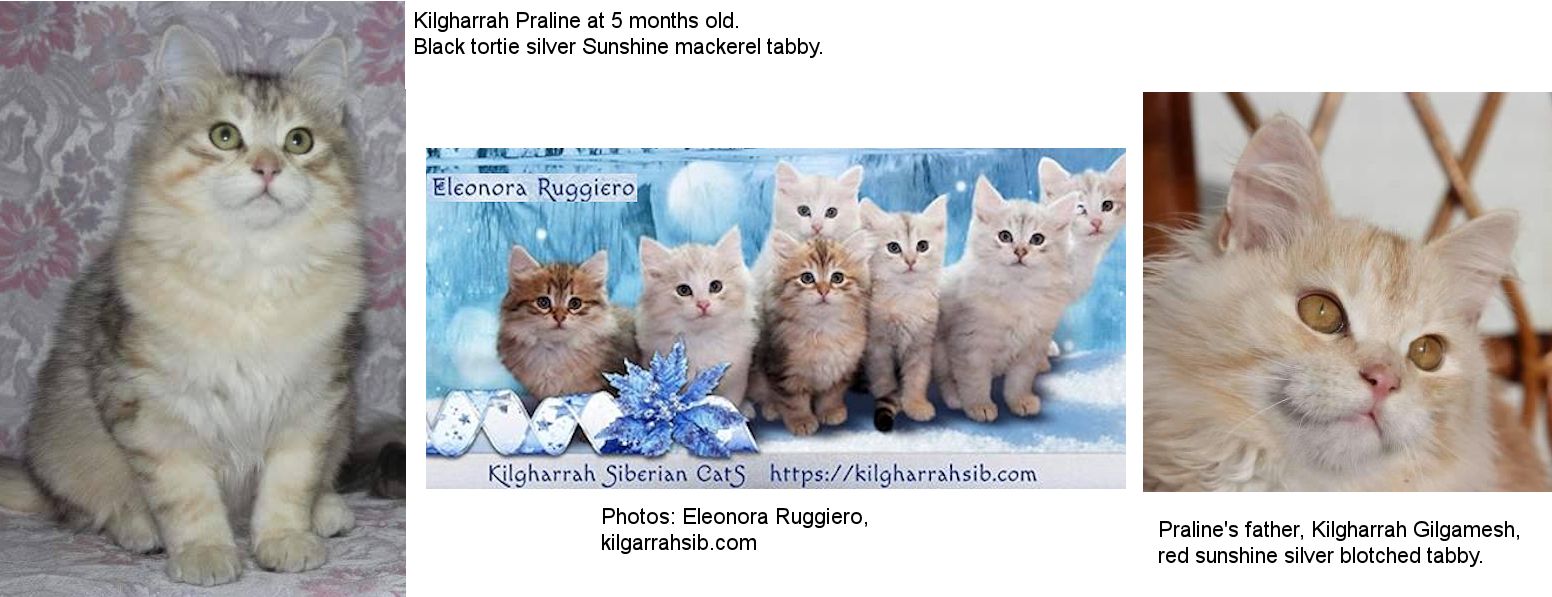
SUNSHINE GENE CORIN GENE MUTATION
A study published in 2021 found that the "sunshine" phenotype in the Siberian breed (a warm tone of tabby, a pink nose lacking the black lining and a large light cream area around the nose) followed an autosomal recessive inheritance pattern. It identified a candidate gene called CORIN (Corin, serine peptidase). CORIN variants have already been identified in mice and tigers with a golden phenotype and CORIN has been described as a modifier of the ASIP (Agouti Signaling Protein) pathway. The hair of Siberian cats was consistent with elongated ASIP signalling - the golden hair showed a large yellow band instead of the short subapical one normally seen in agouti hair. Sunshine phenotype cats were found to be homozygous for CORIN:c.2383C>T missense variant, inherited as a recessive. This variant was also found in three Kurilian Bobtail cats and in two Toybob cats, but genotyping of 106 cats from 13 breeds did not find any carriers in cats from other breeds. The researchers proposed that the CORIN:c.2383C>T variant represents the wbSIB (Siberian recessive wideband) allele in the domestic cat. Sunshine is the first "rufism" gene named and confirmed in cats.
- Beauvois H, Dufaure de Citres C, Gache V, Abitbol M. Siberian cats help in solving part of the mystery surrounding golden cats. Anim Genet. 2021 Aug;52(4):482-491.
In April 2022, Professor Marie Abitbol announced that a second mutation of sunshine ( extreme sunshine ) had been identified and is a second allele on the CORIN locus. Cats can be sunshine, extreme sunshine and extreme sunshine carrying sunshine.
SUNSHINE COLOUR IS RECOGNISED
In 2022, the CORIN silver and gold colours were officially recognized as TICA championship colours for Siberian, Toybob and Kurilian Bobtail breeds. CORINs are always tabbies and only recognized as black based colours (black/blue/chocolate/cinnamon, and no torties allowed). CORIN golds fall in the traditional or pointed tabby divisions. CORIN silvers (bimetallics) fall in the traditional or pointed silver/smoke divisions. Because the term sunshine has also been adopted for British Shorthairs, the gene name is used instead e.g. blue corin mackerel tabby, chocolate corin silver classic tabby, black corin gold spotted tabby. Corin silver is the TICA name for the Siberian sunshine silver cats that were colloquially called bimetallics.
When golden cats appeared in silver Siberians, it resulted in cats expressing both colours in the coat; something impossible in Persian golden. The degree and intensity of golden colour ruled out rufism or tarnish. Early sunshine cats were dismissed as silvers with high degrees of rufism and not bred from. There needed to be a way of describing the brighter tone of some Siberian cats without using the word "golden". Siberian breeders asked for the term "Sunshine" to be recognised so that this gene could be discussed and traced in pedigrees without it being linked to cats with silver ancestry. Sunshine resembles amber, but has important difference: sunshine kittens are born with black, not pink, pawpads which allows them to be distinguished from cats with the inhibitor gene.
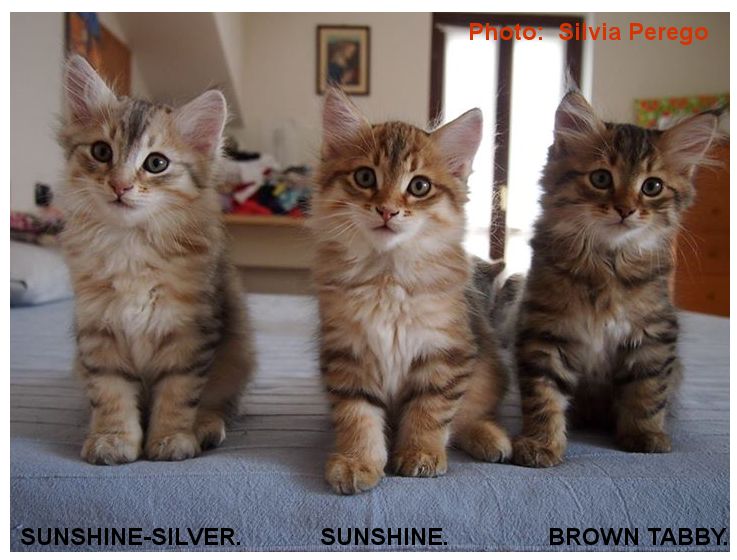

Sunshine silver looks very different from a silver with rufism; the nose leather is pinkish unlike that of a tabby cat. The red colour of a sunshine red tabbies and sunshine torties is brighter and the paws are lighter. The absence of pigment in the sunshine tabbies extends beyond the edges of the nose leather so they have no nose-liner and have whitish fur at the bottom of the nose. Sunshine has been established in a breeding programme that used much inbreeding to bring out this recessive trait. In 2013, all known sunshine Siberians were agouti (tabby markings) and the colour hadn t been seen in non-agouti (solid) cats. The sunshine gene affects the agouti (ticked) hairs only and not the solid hairs of the markings. Sunshine is inherited recessively. If you look at the pedigree of a Siberian Sunshine, it is apparent that sunshine cats can be born to two "non-sunshine," but when two sunshine cats are bred together they produce ONLY sunshine kittens. It brightens the agouti (ticked) areas of the coat.
In many Silver carriers of sunshine, we can see they are carriers because they nose leather is similar colour to a normal silver tabby, but there are brownish/reddish patches on the upper parts of the body (sometimes mistaken for tortie). Other silver cats carrying sunshine have no sign of the sunshine gene at all and are normal silvers! In red/cream silvers, the presence of sunshine can produce more intense reddish patches on the upper parts which can cause the pseudo merle effect of reddish patches on a cream cat.
Suzanna Multhaupt has been looking into the golden colour and provided further information. The true black golden tabby Siberian is free of shading and free of silver influence. Characteristic honey-golden markings come in classic (blotched), mackerel and/or spotted tabby but the undercoat is golden in all cases with the tip of the hairs black (probably Wb). So depending on the season, the coat will appear darker or lighter. The kittens are born very dark. Distinguishing factors are jet-black paw-pads with long fur between the toes, black eye-liner and green eyes. The nose is pink and has no pigmentatation. Lips, too, are pink. The chin and chest are white but not solid colored. She has found it almost impossible to get a "pure" black golden from non-black-golden parents. As soon as you cross a black golden with any other color, be it agouti or non agouti, the golden undercoat disappears and you get interesting tabby offspring but no black-goldens. This is possibly where sunshine silver comes in.
We can have Brown/blue/tortie sunshine tabby for the cats without the inhibitor (silver) gene and Black/blue/tortie sunshine silver tabby or silver shaded for where the inhibitor (silver) gene is present. These can be in all tabby varieties (ticked tabby is not permitted by GCCF in Britain), with or without white, or in silver shaded. The same colours are permitted in colourpoint patterns for the Neva Masquerade. The sunshine gene does not affect eye colour so this remains blue in the Neva Masquerade, preferable green in sunshine-silver cats and the normal eye colours for all other colours and patterns. A sunshine tabby without silver typically has pink nose leather without any dark line around it, and a very warm ground colour. Kittens are born with black, blue or tortie colours, but as they age these colours fade and can disappear resulting in warm apricot-reddish hairs with a tabby pattern and few dark hairs. The under parts are lighter. The paw pads match the base colour (black, blue, tortie etc), or are pink in cats with white paws. Sunshine silvers have both silver areas and sunshine areas.
Siberian cats that are sunshine non-agouti (aa) i.e non-tabby-patterned, have nose leather that matches the marking colour e.g. black, blue. Non-agouti sunshine/extreme sunshine cats do not have any blonde in their coat. Sunshine/extreme sunshine can only be seen when the cats are agouti (tabby). Sunshine colouration appears darker at birth and gets clearer as the cats mature. Sunshine can occur in combination with colourpoint in the Neva Masquerade (colourpointed Siberian).
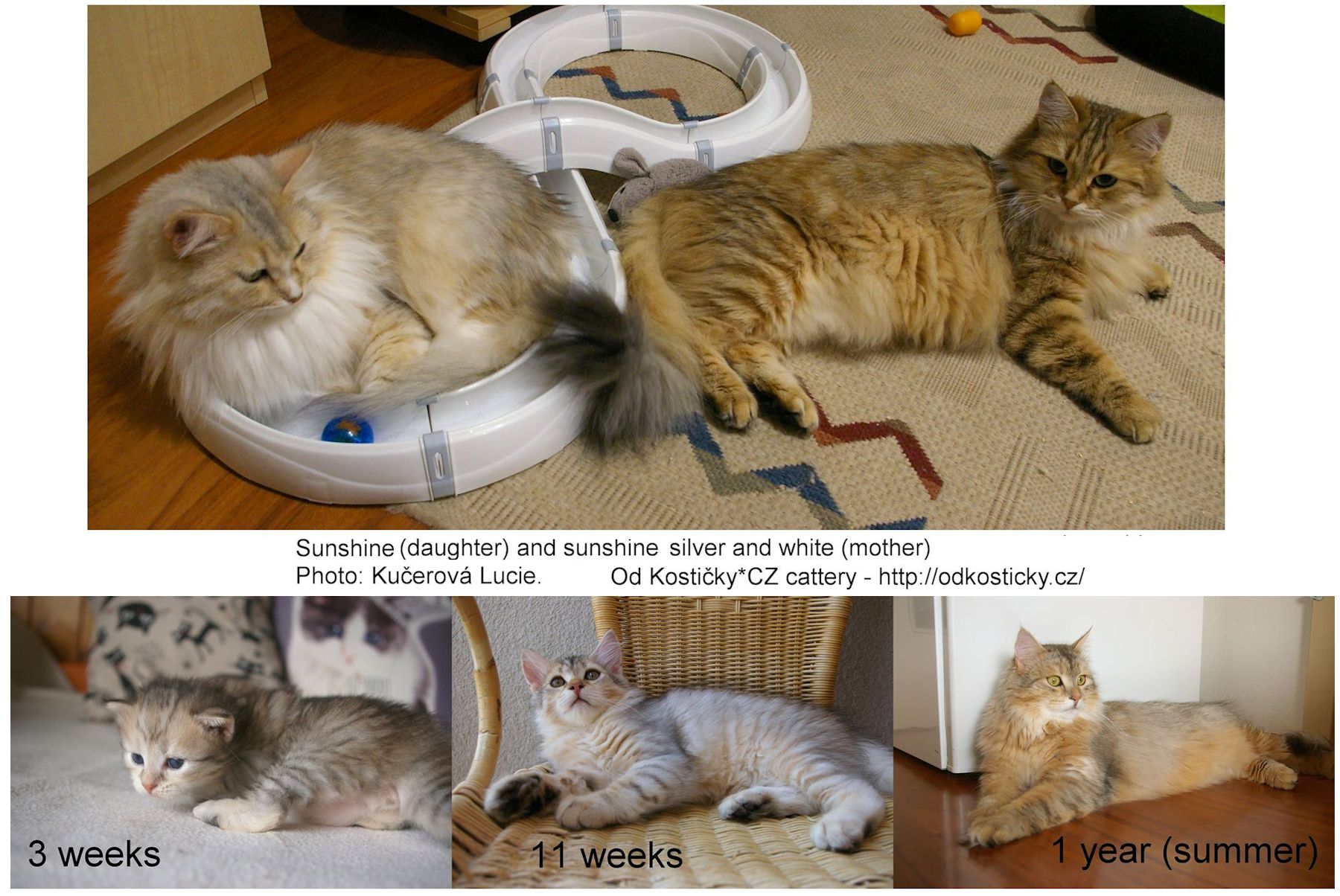
SUNSHINE AND GOLDENSIB
Eleonora Ruggiero (All Breed WCF judge) presented an update on the genetic transmission of Siberian "Golden" (GoldenSib) and Siberian "Sunshine" in 31 March 2018. It s hard to continue the research while breeders register Sunshine cats as Goldens, and because cats born before 2017 were considered Golden at that time. The golden in the Persian cats shows "Wide banding" and is a "tipped" colour. The Golden in the Siberians is usually tabby. Sunshine and GoldenSib both appear to be recessive traits. A GoldenSib has nose leather the same colour as a normal tabby, but the base of coat is a warm hazelnut colour, not black or grey like a normal tabby. A "Sunshine" cat has pink nose leather and the base of the fur is apricot or light hazelnut. Sunshine carriers have warm hazelnut fur and the base of the fur is less grey or black than non-carriers of the gene. The Sunshine colouration looks darker at birth getting clearer afterwards, somewhat similar to the amber (ee) in the Norwegian Forest cats (which also produces pink nose leather). Sunshine cats do not have the amber or russet extension gene mutations. They might be due to another extension gene mutation, or to a different gene entirely. What is known for certain is that:-
Sunshine x sunshine produces only sunshine offspring.
GoldenSib x GoldenSib producse both Siberian Gold or Sunshine kittens.
Non-Sunshine/non-GoldenSib x non-Sunshine/non-GoldenSib produces non-Sunshine/non-GoldenSib kittens OR Sunshine kittens or GoldenSib kittens.
Sunshine x GoldenSib can produce Sunshine or GoldenSib kittens.
Sunshine x non-Sunshine/non-GoldenSib can produce non-Sushine/non GoldenSib, or Sunshine, or GoldenSib.
Eleanor hypothesises that the genes for GoldenSib and for Sunshine are two different alleles on the same locus. They are both recessive compared to non-GoldenSib/non-Sunshine. GoldenSib is dominant over Sunshine. The order of dominance appears to be: Non-GoldenSib/non-Sunshine >> GoldenSib >> Sunshine
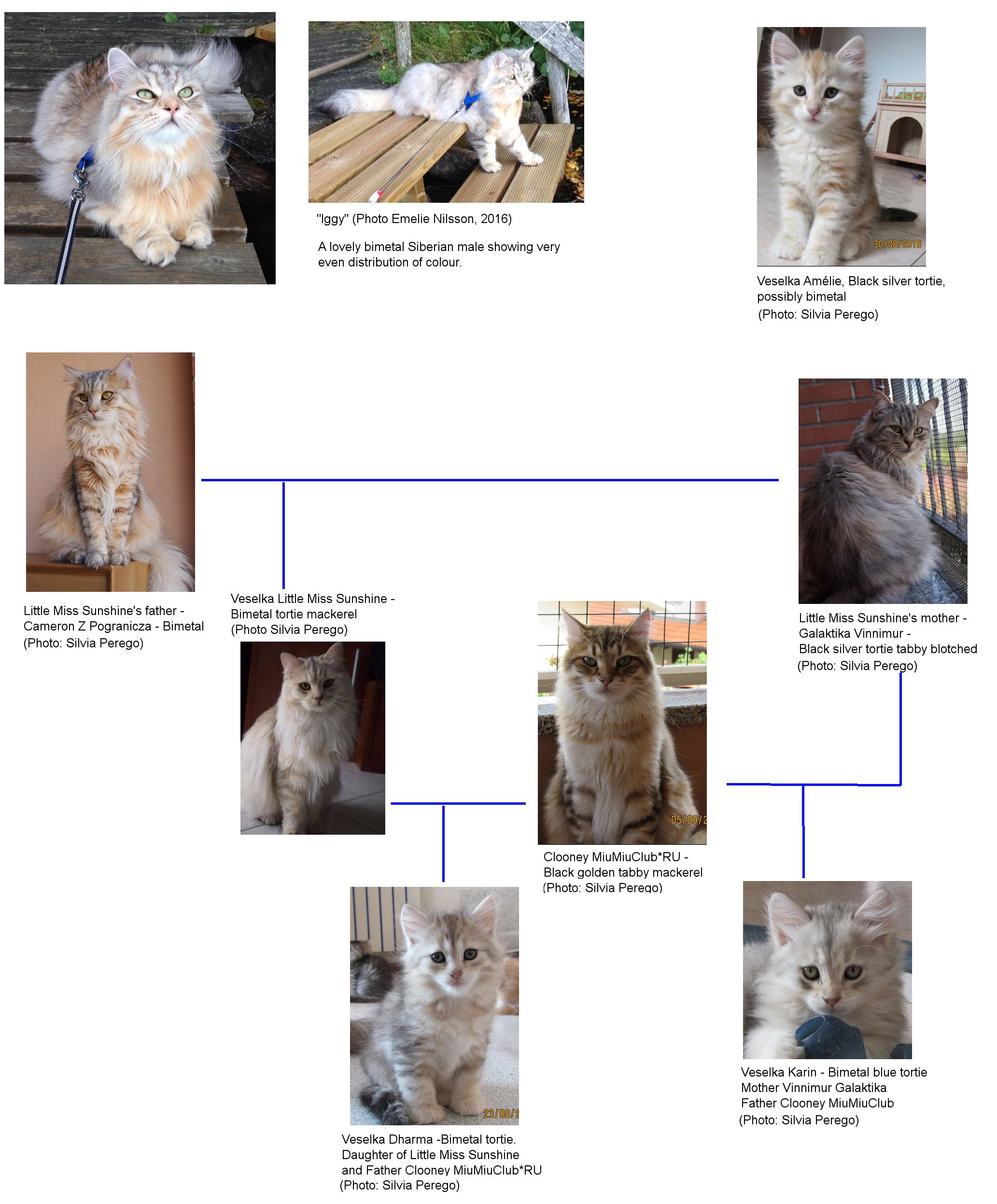
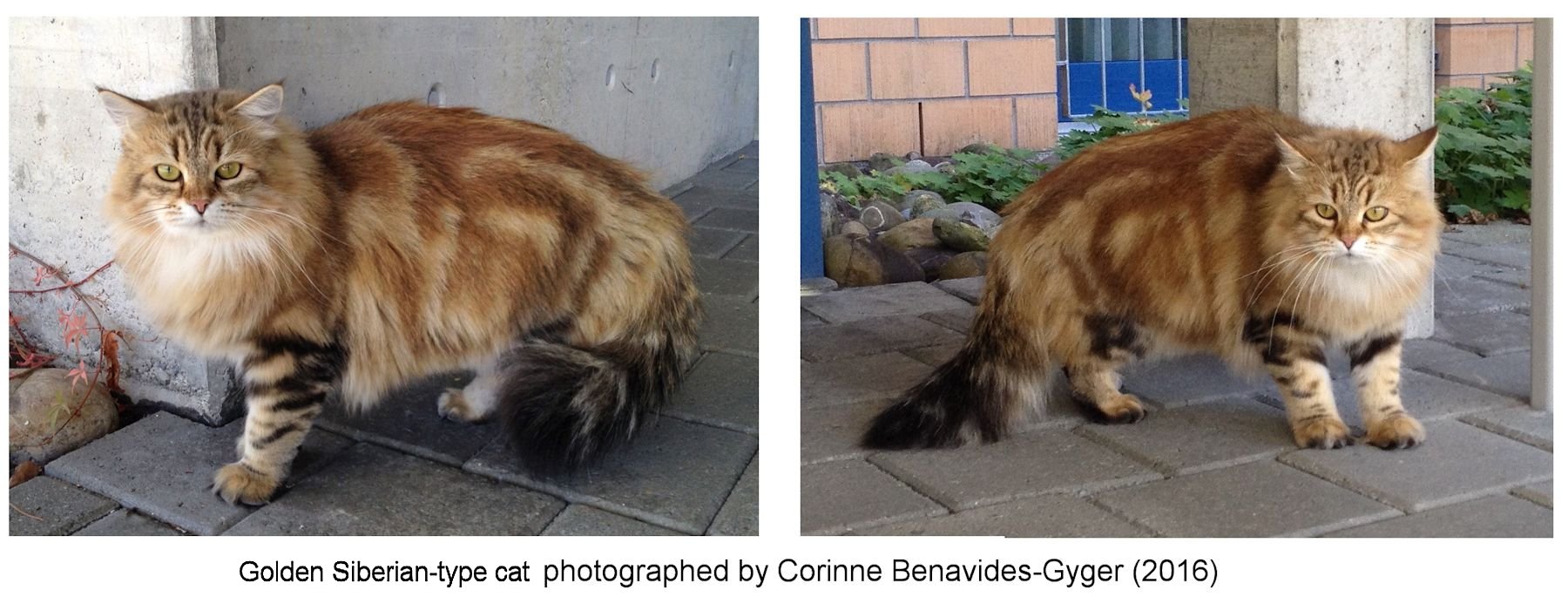
Emelie Nilsson (2016) has bred a male (Miss Emmi's Iggy Innocent, pictured) which appears to be a combination of the Siberian sunshine and the silver gene. She has also bred a sunshine Siberian (Miss Emmi's Leopold Leopard). Both these boys have non-golden parents. To make matters even more complex, there is also a colour called "blue golden", which is a combination of the dilution gene and sunshine gene. Emelie notes "It might well be that some Siberians have the "golden-Persian-gene", since Persians were probably mixed into the breed early on. This might result in a situation where we have two different "golden genes" in the breed, one dominant and one recessive. Of course, this adds to the confusion. I have myself seen brown agouti Siberians that are all different shades: from almost golden without the typical pink nose, to an a very dark, more charcoaly colour. There may be many modifying genes at play."
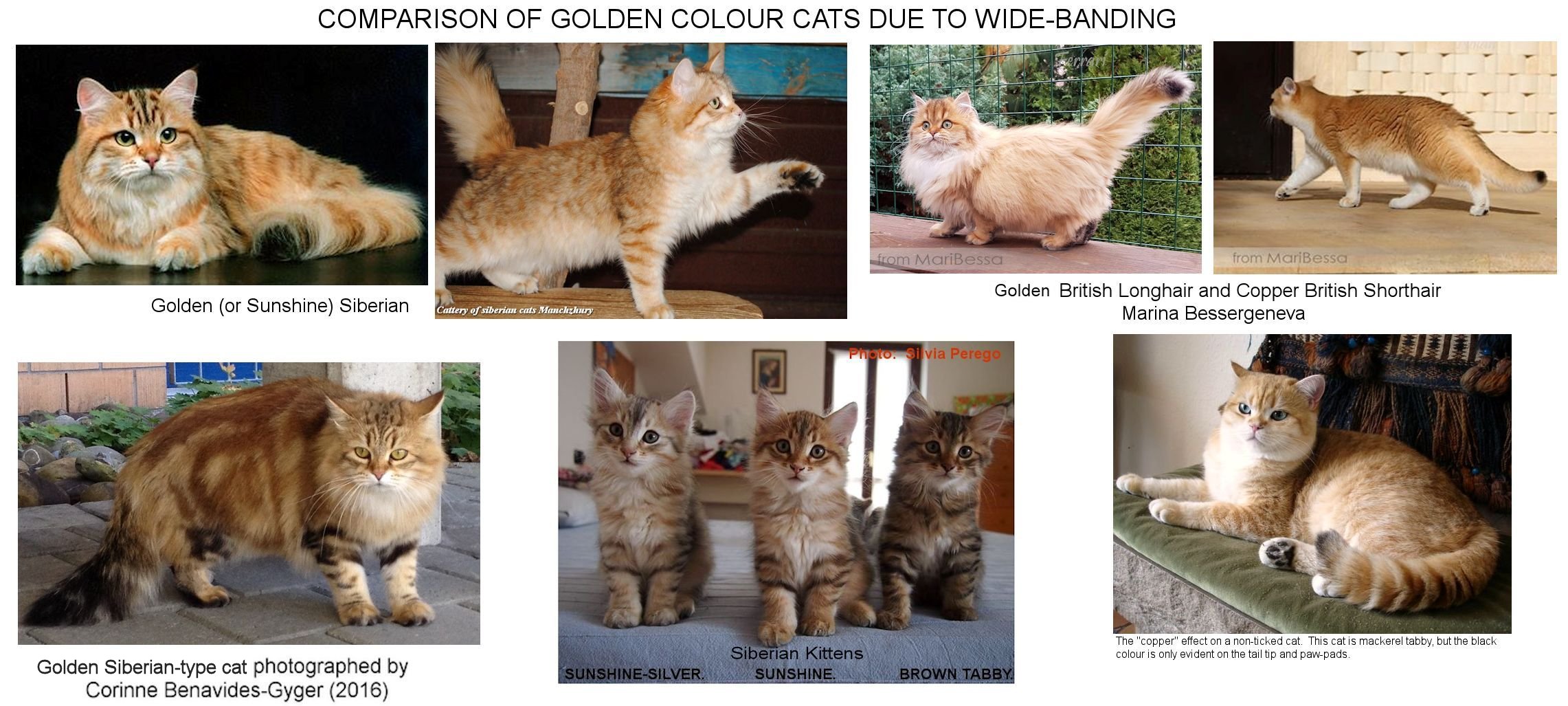
HOW TO DIFFERENTIATE BROWN TABBY, SUNSHINE AND "DARK SUNSHINE" AND "EXTREME SUNSHINE."
The mutation causing the sunshine and dark sunshine phenotype is wbSIB. It was identified in 2019 and published in 2021. Other genes involved in these colours are Agouti (identified) and Inhibitor (Silver).
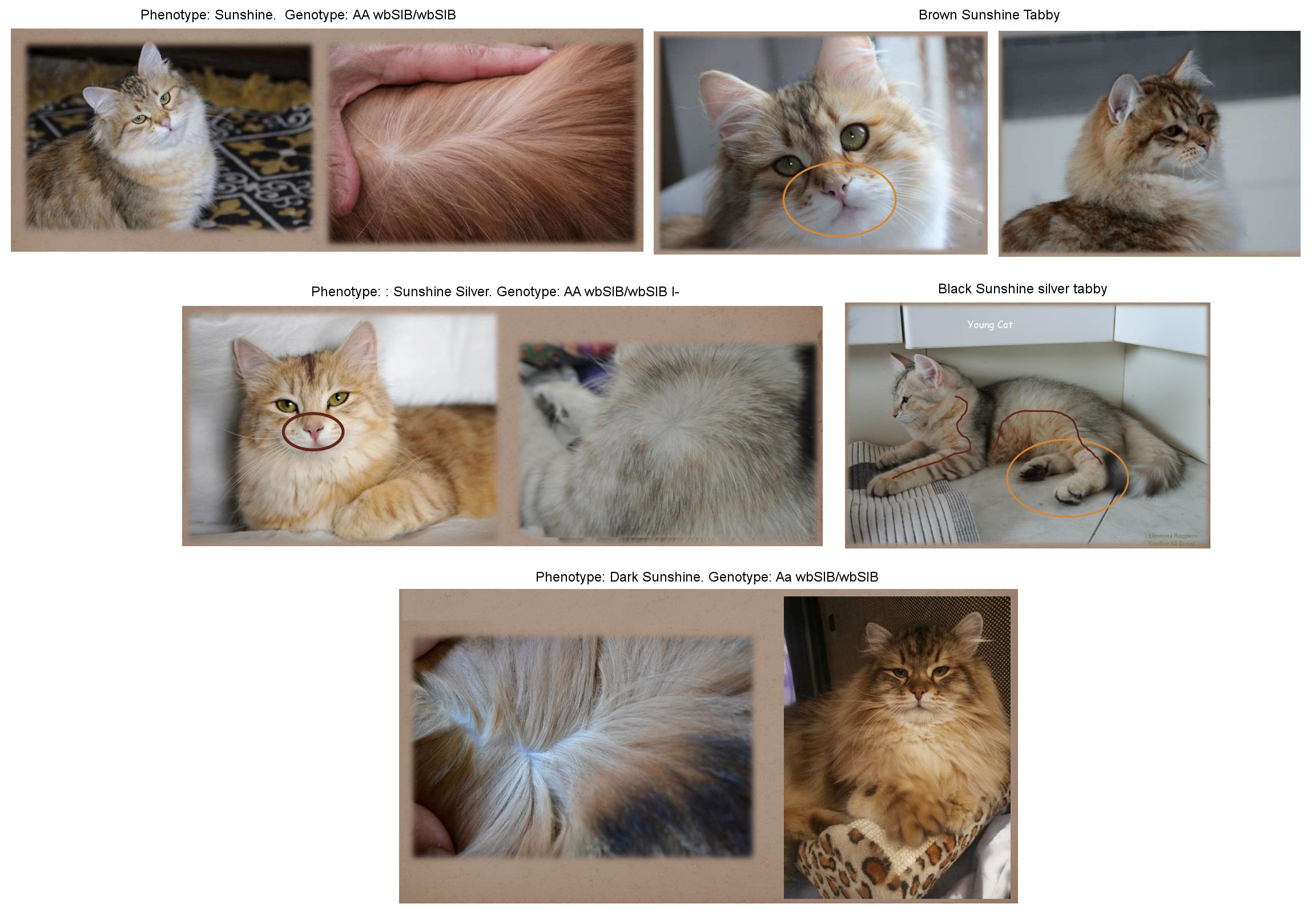
Based on data available as at Feb 2022, the "extreme sunshine" mutation in Siberians could be a second mutation on the sunshine locus, which is recessive to "full colour," but variably dominant over sunshine. At present no "extreme sunshine" phenotype cats have been identified that are also homozygous for sunshine. There are sunshine heterozygotes and non-sunshine cats, and those without sunshine have a more extreme phenotype. This suggests that "extreme sunshine" and "sunshine" are at the same locus. It is important to have as much data as possible to exactly identify the method of transmission (if you have Siberian cats with this phenotype, please contact ricerca@abissini.com Eleonora Ruggiero)
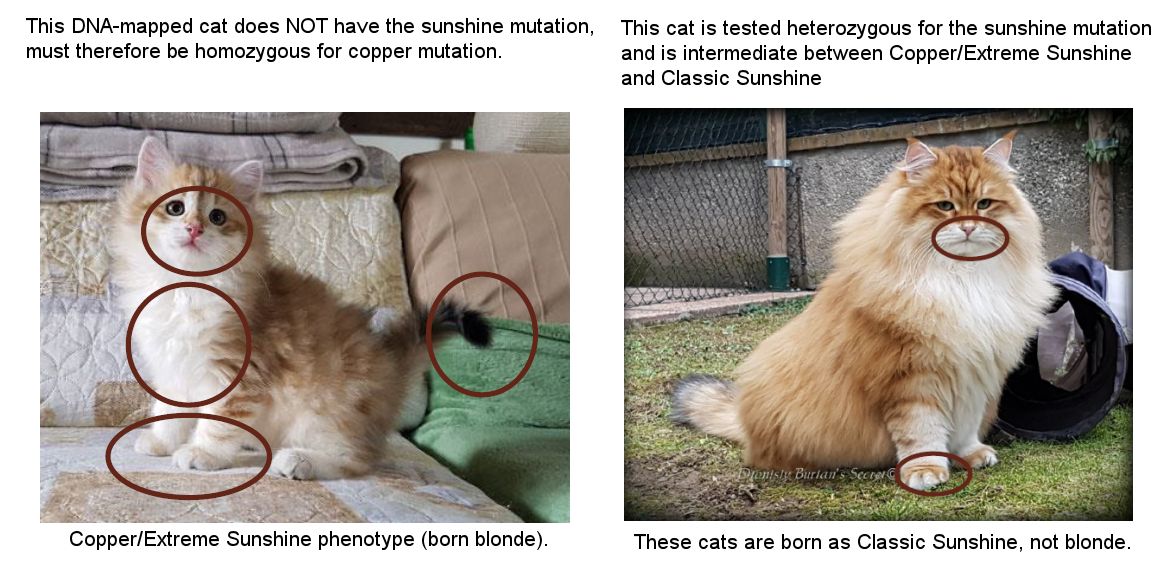
HETEROZYGOUS SUNSHINE / EXTREME SUNSHINE (INTERMEDIATES)
Some wbESIBSIB (heterozygous sunshine/extreme sunshine, including silver sunshine/silver extreme sunshine) are phenotypically between sunshine and extreme sunshine. They appear to have white patches one nose, chin, chest and legs but do not have the white spotting gene.
SUNSHINE AND WHITE
Sunshine and extreme sunshine with white tend to have their colour in patches, perhaps due to the white spotting gene influencing cell migration across the body.
GENEALOGIES.